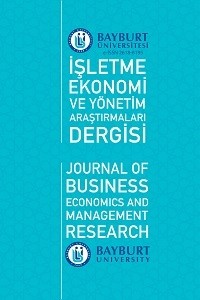DÖVİZ KURUNDAKİ DEĞİŞİMLERİN YABANCI KONUT TALEBİNE ETKİLERİ: TÜRKİYE ÖRNEĞİ
reel döviz kuru, konut talebi, yabancı konut talebi
THE EFFECTS OF CHANGES IN EXCHANGE RATE ON FOREIGN HOUSİNG DEMAND: IN TURKEY
Real Exchange Rate, Housing Demand Housing Sales to Foreigners, Foreign Housing Demand in Turkey, Time Series Analysis,
___
- Altıntaş, H., & Koçbulut, Ö. (2017). Enerji Tüketimi ve Ekonomik Büyüme İlişkisi: Gelişmiş Ülkeler Üzerine Eşik Eşbütünleşme ve Nedensellik Analizi. Akademik Sosyal Araştırmalar Dergisi, 5(44), 32-51.
- Arthur O’Sullivan (2011). Urban Economics-McGraw-Hill Education. United States of America: Douglas Reiner.
- Asal, M. (2018). İsveç Reali Konut Fiyatlarının Uzun Vadeli Sürücüleri ve Kısa Vadeli Dinamikleri. Uluslararası Konut Piyasaları ve Analizi Dergisi, 11, 45-72.
- Ari, A., Puy, D., & Shi, Y.(2020). Foreign Demand and Local House Prices: Evidence from the US. SSRN Scholarly Paper. Rochester, NY: Social Science Research Network.
- Bahmani-Oskooee, M., & Wu, T. P. (2018). Housing prices and real effective exchange rates in 18 OECD countries: a bootstrap multivariate panel Granger causality. Economic Analysis and Policy, 60, 119-126.
- Bekmez, Selahattin& Özpolat, Aslı (2013). Türkiye’de konut talebinin belirleyenleri: Dinamik bir analiz. TİSK Akademi, Cilt 8. Sayı.16, 171-187
- Ceritoglu, E. (2017). “The Effect of House Price Changes on Cohort Consumption in Turkey”. Working Papers. Research and Monetary Policy Department, Central Bank of the Republic of Turkey. [Çevrim-içi https://ideas.repec.org/p/tcb/wpaper/1710.html]. Erişim tarihi: 01.01.2022.
- Emlak Konut Yatırım Ortaklığı A.ş (2018). Gayrimenkul ve konut sektörüne bakış. Erişim adresi: https://emlakkonut.com.tr/. Erişim tarihi: 06.09.2021.
- Ferreira, N. B., Menezes, R., ve Bentes, S. (2014). Cointegration and structural breaks in the EU sovereign debt crisis. Cointegration and Structural Breaks in the EU Sovereign Debt Crisis, (1), 680-690.
- Geng., N. (2018). Fundamental drivers of house prices in advanced economies. International Monetary Fund.
- Gorback, C. S., ve Keys, B. J. (2020). Global capital and local assets: House prices, quantities, and elasticities (No. w27370). National Bureau of Economic Research.
- Han, L. (2010). The effects of price risk on housing demand: empirical evidence from US markets. The Review of Financial Studies, 23(11), 3889-3928.
- İpekyolu Kalkınma Ajansı. (2011). Orta Doğu Durum Raporu, Gaziantep: İpekyolu Kalkınma Ajansı Yayınları.
- Kalim, R ., & Shahbaz, M. (2009). Remittances and Poverty Nexus, Evidence From Pakistan, International. Research Journal of Finance and Economics ISSN 1450-2887 Issue 29 (2009)
- Karasu, M. N. (2015). Understanding real estate bubbles: An analysis of the recent trends in the Turkish housing market, Master's thesis, Middle East Technical University.
- Kıral, G., ve Çelik, C. (2018). Panel veri analizi ve kümeleme yöntemi ile Türkiye’de konut talebinin incelenmesi. Atatürk Üniversitesi İktisadi ve İdari Bilimler Dergisi, 32(4), 1009-1026.
- Oktay, E., Karaaslan, A., Alkan, Ö., ve Çelik, A. K. (2014). Determinants of housing demand in the Erzurum province, Turkey. International Journal of Housing Markets and Analysis.
- Önder, K. ve Turgut, H. (2018). Examination of the Factors Affecting Household Rental Housing Demand Through Data Mining. Eskişehir Osmangazi Üniversitesi İktisadi ve İdari Bilimler Dergisi, 13(2), 227-238.
- Özaktaş, F. D. (2019). Yabancılara Konut Satışı Ve Reel Efektif Döviz Kuru: Türkiye Örneği Ampirik Çalışma. Ekonomik ve Sosyal Araştırmalar Dergisi, 15(1), 131-147.
- Özdemir, S. (2018). Gayrimenkul Sektöründeki Yasal Düzenlemelerin Yabancı Yatırımcılar Üzerine Etkisi. Master's thesis, İstanbul Gelişim Üniversitesi Sosyal Bilimler Enstitüsü.
- Saiz, A. (2007). Immigration and housing rents in American cities. Journal of urban Economics, 61(2), 345-371.
- Stepanyan, V., Poghosyan, M. T., & Bibolov, A. (2010). House price determinants in selected countries of the former Soviet Union. International Monetary Fund.
- Taghizadeh-Hesary, F., Yoshino, N., & Chiu, A. (2019). Internal and external determinants of housing price booms in Hong Kong, China.
- Türkiye Cumhuriyeti Merkez Bankası, https://www.tcmb.gov.tr/ Türkiye İstatistik Kurumu, Konut Satış İstatistikleri, Erişim: https://data.tuik.gov.tr/Bulten/Index?p=Konut-Satis-Istatistikleri-Mayis-2022-45677
- Tripathi, S. (2019). Macroeconomic Determinants of Housing Prices: A Cross Country Level Analysis.
- Uyar, S.G ve Kılıç, E. (2017). “Yabancıların Konut Talebinin Türkiye’deki Bölgesel Konut Talebi Üzerine Etkisi: Mekânsal Ekonometrik Analiz”. 292-306.
- Ya-Chen, L., & Shuai, Z. (2013, July). Econometric analysis on the relationship between RMB exchange rate and real estate price by VAR model. In Second International Conference on Science and Social Research (pp. 428-430).
- ISSN: 2618-6195
- Yayın Aralığı: Yılda 2 Sayı
- Başlangıç: 2018
- Yayıncı: Bayburt Üniversitesi
EKONOMİK KARMAŞIKLIK VE EKOLOJİK AYAK İZİ İLİŞKİSİ: TODA-YAMAMOTO NEDENSELLİK ANALİZİ
Ş. Mustafa ERSUNGUR, Elifnur TIĞTEPE, Fatma KILIÇ
KIRGIZİSTAN’DA MUHASEBE KAVRAMI VE KIRGIZ MUHASEBE SİSTEMİNDE YASAL DÜZENLEME
Erol IŞIKÇI, Tuğrul Tekin TUNALILAR
SUYUN METALAŞMASI BAĞLAMINDA TÜRKİYE’DE HİDROELEKTRİK SANTRALLER: FINDIKLI ÖRNEĞİ
ÖRGÜTSEL DEĞİŞİM VE ÖRGÜTSEL ÇATIŞMA ARASINDAKİ OLASI İLİŞKİ ÜZERİNE BİR FARKINDALIK ÇALIŞMASI
DÖVİZ KURUNDAKİ DEĞİŞİMLERİN YABANCI KONUT TALEBİNE ETKİLERİ: TÜRKİYE ÖRNEĞİ
Rüstem YANAR, Canan Şeyma DEMİR
BİR KAMU POLİTİKASI OLARAK SOSYAL GÜVENLİK TEMELİNDE EMEKLİLİK
